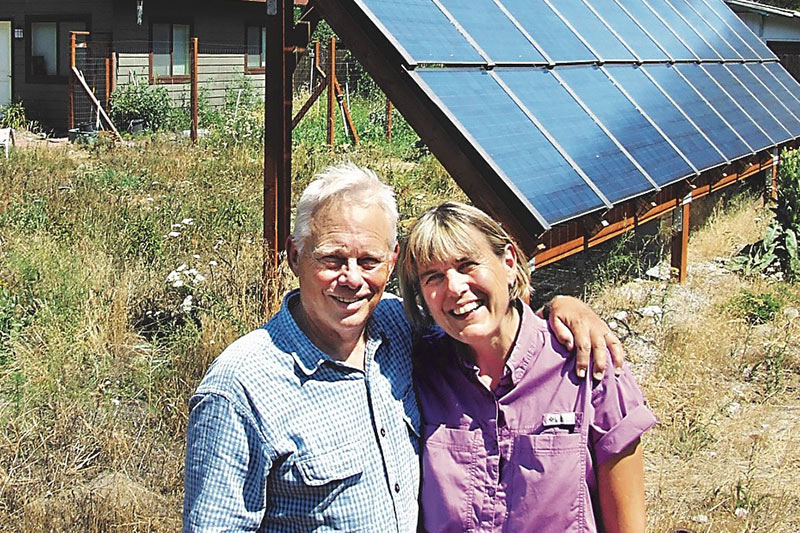An Overflow of Abundance: Barbara Rossing and Lauren Johnson

If you talk to Barbara Rossing about her call to theological education, you’ll hear a word often repeated: abundance.
Rossing grew up in Northfield, Minn., with a current population of nearly 21,000. It’s the home of Carleton College, where Rossing studied geology as an undergraduate. She comes from a family of scientists. Rossing’s father was a physicist who taught at St. Olaf College (also in Northfield) and her mother a chemist. But Rossing also comes from a long line of Lutheran pastors. Her grandfather was a pastor in the Evangelical Lutheran Church, a predecessor of the American Lutheran Church, and one of her sisters is also an ELCA pastor.
The symbiosis of a rich religious identity and a deep scientific passion is a thread that runs through Rossing’s career. After graduating from Carleton, she received an MDiv from Yale Divinity School. She served as a pastor in Minnesota, as director of Global Mission Interpretation for the American Lutheran Church (an ELCA predecessor body), and eventually as pastor at Holden Village, a Lutheran retreat center in the Cascade Mountains of Washington state. There, consistent with the religion-science theme, she was surrounded by both snow-capped biodiversity and devoted people of faith.
But it wasn’t long before Rossing realized she needed further training. She was encouraged by two professors to pursue studies at Harvard Divinity School, where she eventually completed a doctorate in theology and served as chaplain. She began teaching New Testament at LSTC in 1994, drawn to the theological commitment to biblical studies and to a scientific approach to environmentalism.
Rossing wasn’t too deep into her teaching career when she met a man named Lauren Johnson. Johnson was likewise the recipient of a rich Lutheran pastoral heritage. He had served a three-point parish in eastern Montana, was a graduate of Luther Seminary, and continued his studies at LSTC, where he learned from great faculty like Vítor Westhelle, Linda Thomas and Antje Jackelén.
Rossing and Johnson met at the Grunewald Guild, a retreat center in Washington state where Rossing and artist Richard Caemmerer co-taught a summer course on “Visualizing the Book of Revelation,” at the intersection of art and faith. Rossing and Johnson were married in 2002, and they split their time between Chicago and Leavenworth, Wash., nestled on the eastern edge of the Cascade Mountains. They are just as passionate about the two large arrays of solar panels powering their house as they are about their local church, where Rossing regularly delivers Sunday sermons.
A Theology of Abundance
Like the abundance that characterizes her life and ministry, the theological idea of abundance characterizes Rossing’s scholarship. Her most recent area of exploration is the Tree of Life, a symbol that can be found in various forms of religious expression.
In Buddhism, the Bodhi Tree is the axis of the world. In Native American spirituality, the roots of the Iroquois Tree hold the world together. In Judaism, the menorah represents the light of God. In Shaker expression, the Tree of Life represents spiritual utopianism.
And the Bible itself is bookended by the Tree of Life. We find it in Genesis, in the middle of the Garden of Eden, and in Revelation where it is on “both sides” of the River of Life. In John’s Gospel, Jesus himself is the life-giving tree, and his followers are the branches.
Rossing finds in each of these symbols an expression of the sense that all of life is connected. There is a mutuality to existence, a mystical communion, that leads in turn to a shared responsibility.
She finds a similar awareness in the various Trees of Life used by biologists to track genetic lineage. Rossing explores Darwin’s 19th century sketch of cellular organisms, the phylogenetic tree of genome sequencing, the mapping of multicellular organisms to the Precambrian Era, and the biological tree of life that sequences over 2 million organisms. For Rossing, all of these trees demonstrate what biologist Stephen Jay Gould would call our “Wonderful Life.”
Sharing the abundance: Giving Day 2022
It is with this rich personal and theological heritage serving as a backdrop that Rossing and Johnson likewise give to LSTC as donors. Rossing and Johnson are among the lead donors who have helped kick off Giving Day, a 24-hour period (April 5-6) during which LSTC alumni and friends across the globe gather around our mission. This year, the focus of Giving Day is on scholarships, particularly for students of color.
When asked why she gives to LSTC, Rossing says, “We help future preachers proclaim Jesus’s abundance as a transformative vision of healing for congregations and for our world. There are multiple competing gospels out there.” And this is nothing new. In Turkey, where Rossing leads an educational tour with her LSTC colleague Esther Menn, “You see monuments and arches everywhere with the Greek word euangelion, or ‘gospel.’” The Roman Empire’s Caesar Augustus declared his own birth a gospel. An inscription in the city of Priene, Turkey, reads: “The birthday of [Augustus] has been for the whole world the beginning of the gospel.” In this Roman context, gospel is an “empire theology,” representing a winner-take-all approach to life.
Jesus’s gospel is radically different, Rossing says. It proclaims hope for the struggling and the marginalized. It is anti-empire and counter cultural. It speaks against those in power and stands with those who would otherwise be ignored and forgotten.
For Rossing, that gospel of Jesus Christ is as important now as it ever has been. If we lose sight of it, we lose sight of our call.
LSTC is thankful for the abundant good news that Rossing and Johnson continue to share–as people of faith, as academics and ministers, and as donors and authentic participants in our shared mission. Together, we are forming visionary leaders who proclaim good news to a deeply interconnected world.
Story by Bill Myatt, director of philanthropic engagement